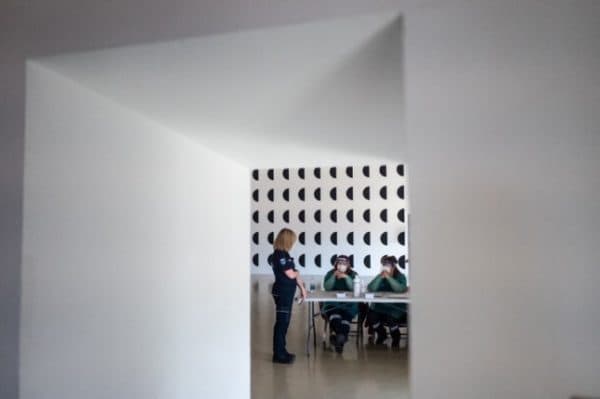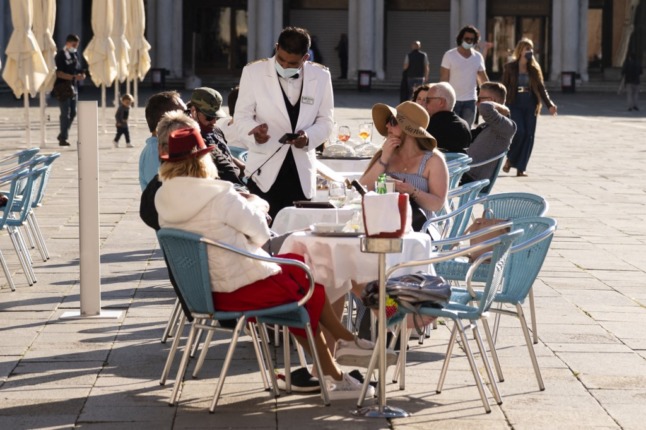Covid-19: Three Italian regions turn 'white' as case numbers continue to fall

Several of Italy's regions are allowed to drop most Covid-19 restrictions from Monday, as new cases and deaths in the country have fallen to a seven-month low.
Three Italian regions - Friuli-Venezia-Giulia, Molise and Sardinia - are under 'white zone' rules from Monday 31st May, following the latest ordinance signed by the health minister on Friday.
Abruzzo, Veneto, Liguria and Umbria will turn white the week after, the government has said.
These regions are being downgraded from 'yellow zone' risk status to 'white' as planned, as the health data continues to improve across the country.
Under 'white zone' restrictions, regions can drop most of the restrictions currently in place in yellow zones, including the evening curfew and the restrictions on opening hours for businesses, including restaurants.
EXPLAINED: How has Italy changed the way it decides regional Covid-19 rules?

Photo by Marco Bertorello / AFP
The regions moving into white zones will be able to drop the last remaining restrictions, and reopen indoor restaurants and bars, fairs, theme parks, conferences and indoor swimming pools and hold weddings earlier than planned under the national roadmap for reopening.
So far, only mask-wearing and social distancing rules must remain in place in white zones, the health minister has said.
For now, nightclubs and discos are still suspended and it is not known if or when Italy may relax the rules on wearing masks outdoors.
And the final set of rules in each region depends on the local authority, as each is free to impose stricter restrictions than those set by the national government.
The regions moving into the low-restriction white zone have registered fewer than 50 coronavirus cases per 100,000 inhabitants for three weeks consecutively - the threshold for determining white zone eligibility.
In fact, they have all hit very low levels with the figure at 17 for Friuli-Venezia-Giulia 13 for Sardinia and 12 in Molise.
MAP: Which parts of Italy will become Covid-19 'white zones' in June?
All indicators in the nation’s latest weekly coronavirus monitoring report, compiled by Italian health ministry and the Higher Health Institute (ISS), showed another decrease in the coronavirus numbers.
The national average weekly coronavirus incidence rate and Rt number had fallen again, while the average daily number of new coronavirus cases is now below 4,000 for the first time since October 10th, the latest data showed on Friday.
Italy on Sunday recorded 44 deaths from Covid-19, the lowest daily tally in more than seven months as the country continues to make progress with its coronavirus vaccinations.
READ ALSO: Italy’s coronavirus infection rate falls to lowest level since October
Though the reported numbers are always lower on Sundays and Mondays, this is the lowest number of deaths since October 14th, when the country had 43 fatalities.
Italy's total death toll from the pandemic now stands at 126,046, according to Civil Protection Agency and Health Ministry data.
The number of people with an active coronavirus infection fell by 3,670 to 236,296, another seven-month low.
Meanwhile, Italy has now administered 34.2 million vaccine doses and 11.8 million people - nearly 20 percent of the population - have been fully vaccinated, the government said.
Comments
See Also
Under 'white zone' restrictions, regions can drop most of the restrictions currently in place in yellow zones, including the evening curfew and the restrictions on opening hours for businesses, including restaurants.
EXPLAINED: How has Italy changed the way it decides regional Covid-19 rules?

The regions moving into white zones will be able to drop the last remaining restrictions, and reopen indoor restaurants and bars, fairs, theme parks, conferences and indoor swimming pools and hold weddings earlier than planned under the national roadmap for reopening.
So far, only mask-wearing and social distancing rules must remain in place in white zones, the health minister has said.
For now, nightclubs and discos are still suspended and it is not known if or when Italy may relax the rules on wearing masks outdoors.
And the final set of rules in each region depends on the local authority, as each is free to impose stricter restrictions than those set by the national government.
The regions moving into the low-restriction white zone have registered fewer than 50 coronavirus cases per 100,000 inhabitants for three weeks consecutively - the threshold for determining white zone eligibility.
In fact, they have all hit very low levels with the figure at 17 for Friuli-Venezia-Giulia 13 for Sardinia and 12 in Molise.
MAP: Which parts of Italy will become Covid-19 'white zones' in June?
All indicators in the nation’s latest weekly coronavirus monitoring report, compiled by Italian health ministry and the Higher Health Institute (ISS), showed another decrease in the coronavirus numbers.
The national average weekly coronavirus incidence rate and Rt number had fallen again, while the average daily number of new coronavirus cases is now below 4,000 for the first time since October 10th, the latest data showed on Friday.
Italy on Sunday recorded 44 deaths from Covid-19, the lowest daily tally in more than seven months as the country continues to make progress with its coronavirus vaccinations.
READ ALSO: Italy’s coronavirus infection rate falls to lowest level since October
Though the reported numbers are always lower on Sundays and Mondays, this is the lowest number of deaths since October 14th, when the country had 43 fatalities.
Italy's total death toll from the pandemic now stands at 126,046, according to Civil Protection Agency and Health Ministry data.
The number of people with an active coronavirus infection fell by 3,670 to 236,296, another seven-month low.
Meanwhile, Italy has now administered 34.2 million vaccine doses and 11.8 million people - nearly 20 percent of the population - have been fully vaccinated, the government said.
Join the conversation in our comments section below. Share your own views and experience and if you have a question or suggestion for our journalists then email us at [email protected].
Please keep comments civil, constructive and on topic – and make sure to read our terms of use before getting involved.
Please log in here to leave a comment.